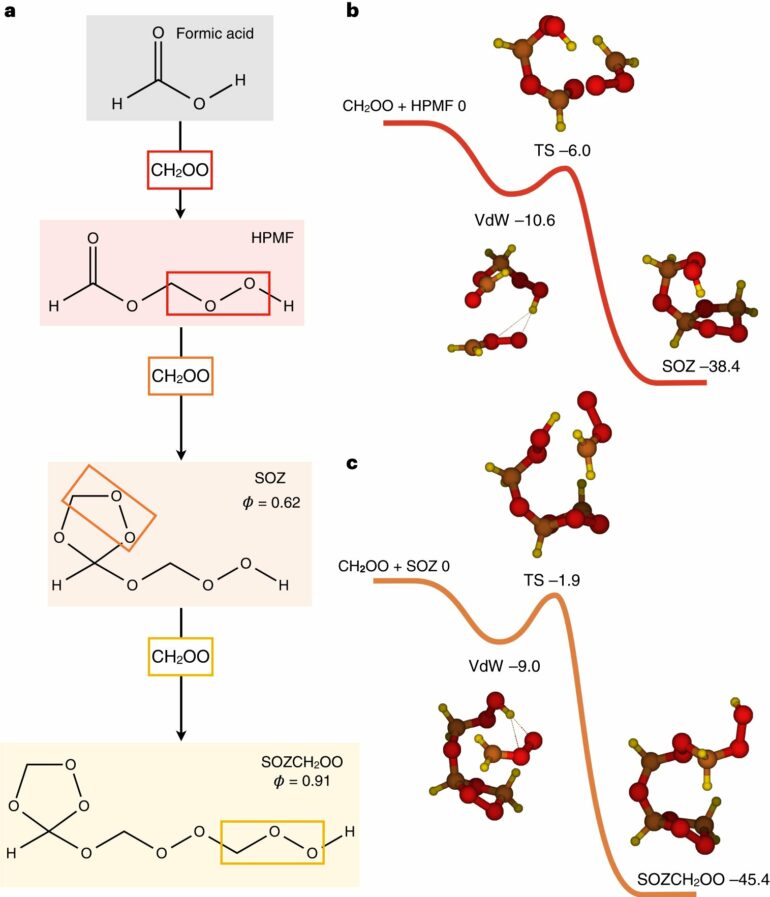Eighty-five percent of the Earth’s air resides in the lowest layer of its atmosphere, or troposphere. Yet, major gaps remain in our understanding of the atmospheric chemistry that drives changes in the troposphere’s composition.
One especially important gap in knowledge is the formation and prevalence of secondary organic aerosols (SOAs), which impact the planet’s radiation balance, air quality and human health. But that gap is closing—due to the groundbreaking discoveries of an international team of researchers led by the U.S. Department of Energy’s (DOE) Argonne National Laboratory, Sandia National Laboratories and NASA’s Jet Propulsion Laboratory (JPL).
The scientists detail their findings in a new paper published in Nature Geosciences.
The team focused on a class of compounds known as Criegee intermediates (CIs). Researchers suspect that CIs play a critical role in the formation of SOAs when they combine via a process called oligomerization. But no one had ever directly identified the chemical signatures of this process in the field—until now.
Using the most advanced methods available for detecting gas-phase molecules and aerosols in the atmosphere, the team took field measurements in the Amazon rainforest, one of the most crucial SOA areas on Earth. There, they found clear evidence consistent with reactions of a Criegee intermediate compound containing carbon, hydrogen and oxygen (CH2OO).
“This discovery is extremely significant because we were able to make direct connections between what we actually saw in the field, what we anticipated was happening with oligomerization of CIs and what we were able to characterize in the lab and determine theoretically,” explained Rebecca L. Caravan, an assistant chemist at Argonne and first author on the paper.
These field observations constitute just one component of the innovative science enabled by the collaboration across the laboratories.
“In addition to the field measurements, we were able to employ the world’s most advanced experimental methods for directly characterizing the Criegee intermediate reactions. We used the most advanced theoretical kinetics to predict reactions we can’t measure directly. And we took advantage of the most advanced global chemistry modeling to assess the effects we would expect oligomerization to have in the troposphere based on those kinetics,” said Craig A. Taatjes, a combustion chemist at Sandia.
This combination of components produced some critically important findings.
“First, we discovered that CI chemistry may play a bigger role in altering the composition of the troposphere than current atmospheric models account for—probably by an order of magnitude,” said Carl Percival, a researcher at NASA’s Jet Propulsion Laboratory. “Second, the updated modeling that we performed based on our work produced only a fraction of the oligomerization signatures we observed in the field.”
This could mean that CI chemistry could be driving even more transformation within the troposphere, or that other, yet unidentified chemical mechanisms are at work.
“We still have a lot of work to do to fully define the role of CI reactions in the troposphere,” concluded Caravan. “But these findings significantly expand our understanding of one potentially significant pathway for SOA formation in the most important layer of the earth’s atmosphere.”
More information:
R. L. Caravan et al, Observational evidence for Criegee intermediate oligomerization reactions relevant to aerosol formation in the troposphere, Nature Geoscience (2024). DOI: 10.1038/s41561-023-01361-6
Provided by
Argonne National Laboratory
Citation:
Researchers provide unprecedented view into aerosol formation in Earth’s lower atmosphere (2024, March 6)



